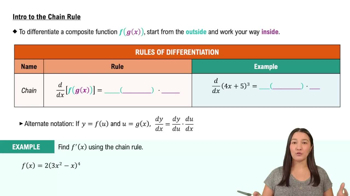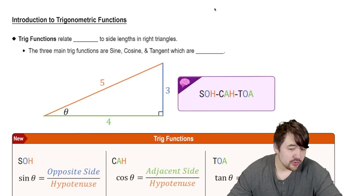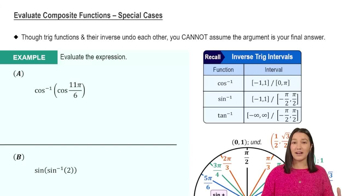Falling meteorite The velocity of a heavy meteorite entering Earth’s atmosphere is inversely proportional to √s when it is s km from Earth’s center. Show that the meteorite’s acceleration is inversely proportional to s².
Table of contents
- 0. Functions7h 54m
- Introduction to Functions16m
- Piecewise Functions10m
- Properties of Functions9m
- Common Functions1h 8m
- Transformations5m
- Combining Functions27m
- Exponent rules32m
- Exponential Functions28m
- Logarithmic Functions24m
- Properties of Logarithms36m
- Exponential & Logarithmic Equations35m
- Introduction to Trigonometric Functions38m
- Graphs of Trigonometric Functions44m
- Trigonometric Identities47m
- Inverse Trigonometric Functions48m
- 1. Limits and Continuity2h 2m
- 2. Intro to Derivatives1h 33m
- 3. Techniques of Differentiation3h 18m
- 4. Applications of Derivatives2h 38m
- 5. Graphical Applications of Derivatives6h 2m
- 6. Derivatives of Inverse, Exponential, & Logarithmic Functions2h 37m
- 7. Antiderivatives & Indefinite Integrals1h 26m
- 8. Definite Integrals4h 44m
- 9. Graphical Applications of Integrals2h 27m
- 10. Physics Applications of Integrals 3h 16m
- 11. Integrals of Inverse, Exponential, & Logarithmic Functions2h 31m
- 12. Techniques of Integration7h 41m
- 13. Intro to Differential Equations2h 55m
- 14. Sequences & Series5h 36m
- 15. Power Series2h 19m
- 16. Parametric Equations & Polar Coordinates7h 58m
3. Techniques of Differentiation
The Chain Rule
Problem 3.6.6
Textbook Question
Derivative Calculations
In Exercises 1–8, given y = f(u) and u = g(x), find dy/dx = f'(g(x)) g'(x).
y = sin u, u = x − cos x
 Verified step by step guidance
Verified step by step guidance1
First, identify the functions involved: y = sin(u) and u = x - cos(x). We need to find dy/dx using the chain rule.
Apply the chain rule: dy/dx = (dy/du) * (du/dx). This means we need to find the derivative of y with respect to u and the derivative of u with respect to x.
Calculate dy/du: Since y = sin(u), the derivative dy/du is cos(u).
Calculate du/dx: For u = x - cos(x), the derivative du/dx is 1 + sin(x), because the derivative of x is 1 and the derivative of -cos(x) is sin(x).
Combine the derivatives using the chain rule: dy/dx = cos(u) * (1 + sin(x)). Substitute u = x - cos(x) into the expression to get dy/dx = cos(x - cos(x)) * (1 + sin(x)).
 Verified video answer for a similar problem:
Verified video answer for a similar problem:This video solution was recommended by our tutors as helpful for the problem above
Video duration:
4mPlay a video:
Was this helpful?
Key Concepts
Here are the essential concepts you must grasp in order to answer the question correctly.
Chain Rule
The chain rule is a fundamental differentiation technique used when dealing with composite functions. It states that the derivative of a composite function y = f(g(x)) is found by multiplying the derivative of the outer function f with respect to its inner function g, by the derivative of the inner function g with respect to x. This is essential for calculating dy/dx when y and u are functions of x.
Recommended video:

Intro to the Chain Rule
Derivative of Trigonometric Functions
Understanding the derivatives of trigonometric functions is crucial for solving problems involving these functions. For instance, the derivative of sin(u) with respect to u is cos(u). This knowledge is necessary to apply the chain rule effectively when differentiating y = sin(u) in terms of x, where u is a function of x.
Recommended video:

Introduction to Trigonometric Functions
Differentiation of Composite Functions
Differentiation of composite functions involves applying the chain rule to find the derivative of a function that is composed of other functions. In the given problem, y = sin(u) and u = x - cos(x) are composite functions, requiring the application of the chain rule to find dy/dx by differentiating each component function separately and then combining the results.
Recommended video:

Evaluate Composite Functions - Special Cases

 5:02m
5:02mWatch next
Master Intro to the Chain Rule with a bite sized video explanation from Patrick
Start learningRelated Videos
Related Practice
Textbook Question
